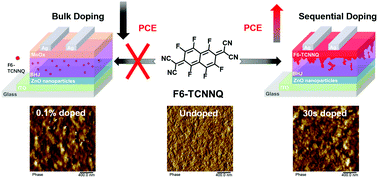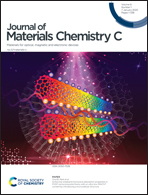Sequential molecular doping of non-fullerene organic solar cells without hole transport layers†
Abstract
While molecular doping has shown the capability to modulate the optoelectrical properties in conjugated polymers or small molecules, some of the widely used dopants (e.g. F4-TCNQ) tend to lead to rapid aggregation in doped host films, forming clusters or large particles which unfavorably impair the morphology and device performance in organic solar cells (OSCs). Here, we report a more gentle doping approach i.e. sequential molecular doping that enables the semiconductive properties of photoactive layers to be modified with negligible damage to the bulk film morphology. Based on a model system of PBDB-T:ITIC bulk heterojunctions, the power conversion efficiency (PCE) of sequentially doped devices with a MoOx hole transporting layer (HTL) is increased to 10.66% (compared to the PCE = 10.01% of the MoOx-containing control device). By controlling the penetration of the dopants, F6-TCNNQ doped devices without MoOx HTLs can produce a PCE of ∼10%, which is comparable to that of the reference cell. The applied sequential doping is mainly found to affect the number of background carriers and the charge transport balance in the doped OSCs, with which carrier extraction is promoted with reduced charge recombination. The results obtained in this work provide a simple methodology for realizing high-efficiency non-fullerene OSCs without using thermally evaporated HTLs.



 Please wait while we load your content...
Please wait while we load your content...